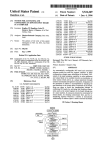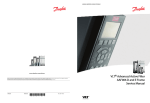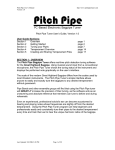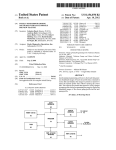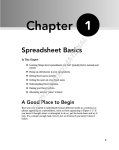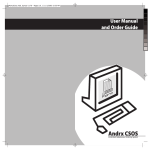Download llllllllllllllIlllllllIllll|||||l||l|Illlllllllllllllllllllllllllllllllllll
Transcript
llllllllllllllIlllllllIllll|||||l||l|Illlllllllllllllllllllllllllllllllllll USOO5557338A United States Patent [19] [11] Patent Number: Maze et al. [45] [54] 5,557,338 Date of Patent: 9/1992 TELEVISION RECEIVER USING RECEIVED 5,151,789 CHANNEL GUIDE INFORMATION AND A SECONDARY VIDEO SIGNAL PROCESSOR 5,223,924 6/1993 Strubble .... .. 348/564 5,353,121 10/1994 Young et al. ......................... .. 348/563 FOR DISPLAYING SECONDARY CHANNEL INFORMATION [75] Inventors: Kenneth W. Maze; Joseph W. Forler, both of lndlanapohs’ Ind' [73] ' Assignee: Thomson Consumer Electronics, Inc., . . . .. .. . . . . . . . . . . . . . .. 358/194 OTHER PUBLICATIONS A portion of the User’s Manual for the Mitsubishi C835 803 Television Receiver Primary Examiner-Safet Metjahic A ' l Sm' tan tExammer—G enton B . B urgess Attorney, Agent, or Firm—Joseph S. Tripoli; Thomas F. Indianapohs’ Ind‘ Lenihan; Peter M. Emanuel [21] Appl. No.: 419,649 [22] Filed: Young Sep. 17, 1996 [57] ABSTRACT AP“ 5 1995 A television receiver system having secondary picture dis ’ play capability (such as PIP 01' POP) includes two tuners and [51] Int. Cl.6 ............................ .. H04N 5/45; H04N 7/173 signal processing arrangements, and circuitry for receiving [52] US. Cl. ........................ .. 348/565; 348/906; 348/731; 3 transmitted channel guide. In response to a “BROWSE” 348/569 command, the receiver maintains the currently-tuned ?rst [58] Field of Search ................................... .. 348/468, 565, channel as the source for the main picture, displays text 348/563, 564, 569, 906, 731; H04N 5/45, related to a television show on a second channel, activates 5/445, 7/173, 7/15 the secondary picture display circuitry, and tunes the second tuner to the second channel. In this way, the viewer can [56] References Cited simultaneously get the bene?t of both a text description of the television show on the second channel and view a US‘ PATENT DOCUMENTS secondary image of the television show on the second 4,706,121 11/1987 Young ................................... .. 358/142 channel, Without tuning away from the ?rst Channel Supply 4,977,455 ing the main picture. 12/1990 Young . .... .... ... . . . .. 358/142 5,047,867 9/1991 Strubble et a1. 5,128,766 7/1992 Choi ...................................... .. 348/564 3100 \ ’ PIPBROWSE 348/564 _ 9 Claims, 5 Drawing Sheets 3200 1 \ O 300D S SATURDAY GOLF g PGA GOLF TOUR LIVE FROM PALM SPRINGS STEREO 1 [EH11 CBL42 6:52 PM 1 305b US. Patent Sep. 17, 1996 Sheet 2 of 5 5,557,338 FIG. 2a PRIOR ART FIG. 2b ' PRIOR ART T ATLANTICYACHTSMAN l) YACHT RACING OFF CAPE COD STEREO w ‘ CHQCBL 41 6:52 PMF I 205D US. Patent Sep. 17, 1996 310a K Sheet 3 of 5 5,557,338 _ \. BROWSE \ 300a \ FIG. 3a PRIOR ART . . . w; SATURDAYGOLF PGA GOLF TOUR LIVE EROM PALM SPRINGS STEREO R CHH CBL42 6:52PM 310E) ’ RPBROWSE ) 320Dl \ “ 300D \ . FIG. 3b V , SATURDAYGOLF. € PGAGOLF TOUR LIVE EROM PALM SPRINGS STEREO & CH11 OO'E'42 6:52PM "-1 1 305b US. Patent Sep. 17, 1996 Sheet 4 of 5 410 r 420 \' BROWSE 03 SATURDAY GOLF PGA GOLF TOUR LIVE FROM PALM SPRINGS STEREO 5,557,338 : K > \ US. Patent Sep. 17, 1996 5,557,338 Sheet 5 of 5 5/5 I SET PIP BROWSE FLAG k I DISPLAY PIP BROWSE MESSAGE, TUNE PIP TUNER TO NEXT CHANNEL IN LIST, DISPLAY PIP IN PIP BROWSE LOCATION DISPLAY BROWSE MESSAGE I I GET TEXT DESCRIPTION OF TELEVISION SHOW ON NEXT CHANNEL IN LIST, DISPLAY TEXT J REMOVE TEXT, CLEAR 560 BROIéILSEEAgLAG, \ PIPBROWSE FLAG, REMIIIIIEIIIIIEXI' TUNE MAINTUNER TOPIP CHANNEL, I BROWSER/LG, I TUNE MAIN TUNER TURN OFF PIP m BROWSE CHANNEL, I I 580 CONTINUE MAIN PROGRAM FIG. 5 530 J 5,557,338 1 2 TELEVISION RECEIVER USING RECEIVED CHANNEL GUIDE INFORMATION AND A SECONDARY VIDEO SIGNAL PROCESSOR FOR DISPLAYING SECONDARY CHANNEL INFORMATION DETAILED DESCRIPTION OF THE EMBODIMENT FIG. 1 shows in block diagram form, the circuitry of a television receiver which receives and processes broadcast television signals. Prior art images produced in such a receiver are shown in FIGS. 2a and 2b. The receiver of FIG. 1 also includes a PIP processor for displaying signals in a much smaller size, known as an inset image. In a sense, FIG. 212 also illustrates the problem to be solved, as will be FIELD OF THE INVENTION The subject invention concerns the ?eld of television receivers, and relates speci?cally to a television receiver using channel guide information and secondary video pro cessing circuitry. explained below. The screen display of prior art FIG. 2a shows a main video image of a sailboat, received on a given channel. The screen display of prior art FIG. 2b shows a main video image of a sailboat, and a text description of the currently-tuned 15 television show, in this case, a description of Atlantic Yacht BACKGROUND OF THE INVENTION Racing. The description is sent along with television signals on a certain channel, and stored in memory. This description may be caused to appear on the screen by pressing a key, More television channels are now available to viewers than ever before. Some cable systems currently deliver thirty channels, and a commercially available satellite system such as INFO, on a remote control unit. Prior art FIG. 3a illustrates the result of a BROWSE oifers up to 150 channels. Several different broadcast chan nel guide displays are available to help the user to organize all this channel information for use. These broadcast channel command sent by a user via a remote control unit. Note that in FIG. 3a, the main image 300a is the same as main image 20% of FIG. 2b (i.e., a sailboat), but the text description rently-tuned television shows. In addition, a user may 25 305a no longer refers to the currently-tuned channel (e.g. cable channel 41), but rather to another television show “browse” other channels without tuning them to see what is guide displays provide on-screen text descriptions of cur (e.g., Saturday Golf) on another channel (e.g. cable channel 42). Note also that the word “BROWSE” appears (310a) in the upper left portion of the screen (300a) in order to alert the user that the displayed text description (305a) bears no currently on the air by sequentially calling up text descrip~ tions of the other channels for display. If the user ?nds the description sufficiently interesting, he may tune the browsed channel by pressing a key (e.g., ENTER) on his remote control unit. Unfortunately, one only gets a text description relationship to the displayed video image. A screen display in accordance with the subject invention is shown in FIG. 3b. In FIG. 3b, a BROWSE command causes the display of a text description of another television of the other television shows; one cannot see the video corresponding to the description of the “browsed” (i.e., untuned) channels. And so, a user may not be fully informed about a given browsed channel. 35 (31%) to appear in the upper left portion of the screen, as described above with respect to FIG. 3a. However, in contrast to the prior art, apparatus according to the subject SUMMARY OF THE INVENTION A television receiver system having secondary picture invention causes the text message “PIP BROWSE” to be display capability (such as PIP or POP) includes two tuners displayed, causes a secondary (PIP (i.e., picture—in-picture, and signal processing arrangements, and circuitry for receiv or pix-in-pix), or POP (i.e., picture-outside-picture)) tuner to tune to the channel carrying the television show correspond ing to the displayed text description (305b) and causes a ing a transmitted channel guide. In response to a “BROWSE” command, the receiver maintains the currently tuned ?rst channel as the source for the main picture, displays text related to a television show on a second show on another channel, causes the main tuner to remain tuned to the current channel, and causes a text message 45 display of the PIP or POP image (3201:) in a predetermined location, so as not to interfere with the display of the text channel, activates the secondary picture display circuitry, description. In this embodiment, the displayed phrase PIP and tunes the second tuner to the second channel. In this BROWSE (31012) alerts the user that the displayed text way, the viewer can simultaneously get the bene?t of both description (305b) refers to a displayed PIP (or POP) video a text description of the television show on the second image. In this way, a video information is conveyed to the channel and view a secondary image of the television show on the second channel, without tuning away from the ?rst viewer that actually does correspond to the displayed text description. Note that in prior receivers which produced the charmel supplying the main picture. 55 BRIEF DESCRIPTION OF THE DRAWING FIG. 1 shows a simpli?ed block diagram of a television receiver suitable for use with the invention. screen display of FIG. 3a, no tuning commands needed to be searched or generated. The displayed text description cor responding to the next channel in the list was merely read from the next area of memory. In contrast, in the subject invention, a search is made of RAM 182, 182' to match channel tuning information with channel information from the BROWSE mode description, and that channel tuning information is applied to a PIP (or POP) tuner 126 for tuning and display in a portion of the FIGS. 2a, 2b, and 3a, show display screens of a television 60 receiver as known from the prior art. FIGS. 3b and 4 show display screens of a television screen away from the text description area. receiver in accordance with embodiments of the subject In a second embodiment of the invention, shown in FIG. invention. 4, it is recognized that when a viewer is already using the PIP FIG. 5 is an illustration of a ?owchart showing the 65 (or POP) function, it may be confusing to the viewer for the relevant portion of the control program for the controller of BROWSE feature to commandeer the PIP (or POP) display FIG. 1. for its own purposes. Therefore, it is envisioned that when 5,557,338 3 4 a viewer is already using PIP (or POP) when the BROWSE AUDIO unit 164 operates under control of controller 180, and includes audio selection circuitry for selecting the feature is invoked, the BROWSE feature will revert to a text-description-only system, and leave the PIP (or POP) proper audio signal which accompanies the main image. In this regard, AUDIO unit 164 has an input for receiving display under command of the user. In such a case, to avoid confusion, the label “PIP BROWSE” may be displayed when the PIP is under control of the BROWSE feature, and label “BROWSE” may be displayed, when the PIP is under AUDIO signals associated with the main signal, and a second input for receiving audio signals associated with the inset signal. control of the user. Note that in FIG. 4, PIP 420 is active and showing a footrace on channel 03, text display 405 is describing a golf tournament on channel 11, and a label “BROWSE” 410 is displayed as an indication that text POWER SUPPLY unit 190, includes both standby and operating power supplies. DEFLECTION unit 192 provides horizontal (H) and vertical (V) de?ection signals, and CON VERGENCE unit 194 controls proper registration of the R, G, and B, color signals on display device 170. description 405 does not apply to the PIP display 420. Note that when BROWSE was activated, PIP display 420 was moved to a location in which it would not interfere with the display of text description 405. With foregoing in mind, the apparatus of FIG. 1, for carrying out the invention, will now be described. RF signals are applied to the input of a signal splitter 110. RF signals from a ?rst output of signal splitter 110 are applied to a main tuner 124 and to an inset tuner 126. Both of the above mentioned tuners are controlled by a controller 180. Con 20 troller 180, includes a RAM (Random Access Memory) 182, a CPU (Central Processing Unit) 184, and a ROM (Read Only Memory) 186. Controller 180 may be a microcom puter, a microprocessor, or a dedicated custom integrated circuit controller. RAM 182 and ROM 186 may be either internal or external to controller 180, although due to the amount of text data to be stored, it is preferable that an external RAM 182' be provided. Controller 180 also controls other portions of the television receiver which are not particularly relevant to the subject invention, such as a power unit 190, a de?ection unit 192, and a convergence assembly 194. RAM 182' may be used to store text descrip tions for display and channel tuning related data for the PIP BROWSE feature. The required descriptions and data are coupled to controller 186 via an input line 142' from a data decoder 142. The operation of a PIP BROWSE feature according to the subject invention will be described with reference to FIGS. 3b and 4, the ?owchart of FIG. 5, and circuitry of FIG. 1. In FIG. 312, an image of a yacht race is received and displayed as the main image 300a, and a video image of a golf tournament is received and displayed as an inset image 32012. A text description 3051; relating to the golf tournament is displayed in a text display area, and a label “PIP BROWSE” 3101; is displayed at the top of the screen. The “PIP BROWSE” is accomplished by use of that portion of the control program of controller 180 which is illustrated in FIG. 5. Step 500 is entered upon receiving a command from a remote control unit (not shown). At step 510, the command is examined to determine if it is a BROWSE command. If so, a BROWSE ?ag is set at step 515 to indicate that the BROWSE function is active. The routine then advances to step 520 to determine if the PIP is already active. If not, at step 524 the PIP BROWSE FLAG is set. At step 525, PIP tuner 126 is tuned to the next channel in the BROWSE list, and the PIP image is displayed at a location in which it will not interfere with the text descrip 35 Main tuner 124 and inset tuner 126 convert their respec tion. At step 530, the text description of the currently running television show on the next channel in the BROWSE list is displayed, and the routine is exited at step 580. tive received RF signals to an intermediate frequency (IF) and apply the IF signal to a respective IF ampli?er 134, 136. and provides audio signals to one input of an AUDIO If at step 520, the PIP were found to be active, then it may be active because the user is already using the PIP feature, ampli?er block 164, which demodulates stereo audio sig nals, ampli?es the signals and applies them to a pair of or it may be that the routine is already in the midst of a PIP BROWSE feature. At step 522 a test is made to determine if the PIP BROWSE FLAG is set. If so, then the routine is in the midst of a PIP BROWSE feature and the routine advances to step 525 to issue PIP-related commands. If the PIP BROWSE FLAG is not set, then PIP is being used by the viewer, and the routine defaults to a text mode only speakers 166. Main picture IF unit 134 and inset picture IF unit 136 are cross-connected to respective poles of an I/O switch arrangement 138 comprising video switches SW2 and SW3 which operate independently of one another under control of controller 180. The wiper (i.e., movable contact) of switch BROWSE feature, by advancing to step 527 at which a SW3 is connected to the input of an INSET IMAGE BROWSE message (as opposed to a PIP BROWSE mes DEMODULATOR 143 which converts the IF signal to a 50 sage) is displayed. The routine then advances to step 530, baseband video signal and applies it to a PIP unit 145 for bypassing the PIP~related commands at step 525. sampling and storage under control of controller 180. The If at step 510, the received command was not a BROWSE output of PIP unit 145 is applied to one input of a VIDEO command, the NO path is taken to step 540 wherein a PROCESSOR unit 144. determination is made as to whether or not the received command is an ENTER command. If not, then the command The wiper (i.e., movable contact) of switch SW2 is connected to the input of an MAIN IMAGE DEMODULA relates to other areas of the command decoding program, TOR 140 which converts the IF signal to a baseband video and this portion of the routine is exited at step 580. If an signal and applies it to the other input of VIDEO PROCES ENTER command was received, the YES path is taken from SOR unit 144. VIDEO PROCESSOR unit 144 creates a step 540 to step 545 to see if the BROWSE ?ag is set. If not combined image comprising a main picture and a PIP, wherein the PIP image is supplied by PIP unit 145. The output of VIDEO PROCESSOR unit 144 is applied to a KINE DRIVER unit 150 for ampli?cation. KINE DRIVER 60 the routine is exited at step 580. If so, the YES path is again taken to step 550 to see if the PIP BROWSE FLAG is set. If so, the routine advances to step 555 where the text display is removed from the screen, the PIP BROWSE FLAG is unit 150 applies the ampli?ed signal to the input terminals cleared (i.e., reset), the BROWSE FLAG is cleared, main of a display device 170. Of course, display device 170 may tuner 124 is tuned to the PIP tuner channel, and the PIP is turned off. The routine is then exited at step 580. If at step 550 the PIP BROWSE FLAG is not set, the routine advances be a picture tube, a set of projection tubes, or an LCD (Liquid crystal display) device. 5,557,338 5 6 to step 560 where the text display is removed from the screen after a few seconds, the BROWSE FLAG is cleared, a second channel on said second tuner for providing and main tuner 124 is tuned to the channel number corre processor to display said secondary image and causes said on-screen display circuit to display text relating to said secondary image, causes said secondary image sponding to the text description (i.e., the BROWSE Chan nel). a television show currently~running on said second It is common practice in the manufacturing of television receivers to install a tuner of greater quality in the main channel, and a tuner of lesser quality in the PIP channel, because the di?erence is not noticeable due to the fact that channel. 2. The television receiver of claim 1 wherein, said con troller causes a display of a menu-selectable option which when selected by a user causes said secondary image processor to display said secondary image in response to said BROWSE command. 3. The television receiver of claim 1 wherein, in response the PIP image comprises only a sample of the available signal for a given channel. Alternatively, in step 555, if the tuners 124 and 126 are of similar quality, then instead of retuning main tuner 124 to the same channel as PIP tuner to said BROWSE command entered by a user, said second ary image is displayed in an area of a display screen not 126, one could merely switch the signals by activating switches SW2 and SW3 of FIG. 1. 15 occupied by said text relating to said television show cur When the PIP BROWSE feature is active, it is possible for rently-running on said second channel. the viewer to move the PIP image to a more desirable location of the screen. This new user-de?ned location can be 4. A television receiver, comprising: stored in memory 182, 182' by controller 180 for use in subsequent PIP BROWSE sessions. The PIP image location for the PIP BROWSE feature would be maintained sepa rately from the normal PIP image location. a second tuner and signal processing arrangement for a ?rst tuner and signal processing arrangement for receiv ing and processing television signals; receiving and processing television signals; user-operable data input circuitry adapted to receive user~ It is recognized that some viewers may prefer not to use the PIP BROWSE feature. Therefore, it is envisioned that the feature be selectable via a menu choice. It is further 25 mands for generating control signals; memory circuitry for storing data relating to television noted that the text description data related to television shows may be transmitted during the vertical blanking interval of a television program, whether from an XDS (extended data service) data stream on the channel being currently tuned, or from a previously received and stored data stream containing information for all channels but entered data or commands; a controller responsive to said user-entered data or com 30 transmitted on a particular channel. The text description data related to television shows also may be transmitted as part shows on a plurality of channels, and storing tuning information for said plurality of channels; a decoder for receiving and decoding said data relating to television shows on said plurality of channels; an on-screen display circuit for generating on-screen of a satellite system’s channel guide. Both of the above given alternatives are envisioned and are deemed to lie 35 within the scope of the following claims. The term “television receiver”, as used in the speci?cation and claims, refers to television receivers having a display display signals; and a secondary image processor for generating signals which when displayed on a display screen cause the display of a secondary image; said controller, in response to the entering of a BROWSE command by a user maintains a currently tuned channel on said ?rst tuner for providing a main image, causes said on-screen display circuit to display text relating to device (commonly called television sets) and television receivers not having a display device (such as, videocassette recorders, satellite receivers, and cable converter units). What is claimed is: a television show currently-running on a second chan 1. A television receiver, comprising: nel, and operates in a ?rst mode when said secondary a ?rst tuner and signal processing arrangement for receiv~ ing and processing television signals; 45 secondary image is active at the time said BROWSE command is received; said controller, in said ?rst operating mode, causes said a second tuner and signal processing arrangement for receiving and processing television signals; user-operable data input circuitry adapted to receive user second tuner to tune said second channel for providing entered data or commands; a controller responsive to said user-entered data or com mands for generating control signals; memory circuitry for storing data relating to television shows on a plurality of channels, and storing tuning information for said plurality of channels; a decoder for receiving and decoding said data relating to said secondary image and causes said secondary image processor to display said secondary image, and in said second operating mode does not cause said second tuner to tune another channel. 55 television shows on said plurality of channels, said decoder having an output coupled to said controller; an on-screen display circuit for generating on-screen 5. The television receiver of claim 4 wherein, said con troller causes a display of a menu-selectable option which when selected by a user causes said ?rst operating mode to be enabled. 6. The television receiver of claim 4 wherein, in said ?rst operating mode, in response to said BROWSE command entered by a user, said secondary image is displayed in an area of said display screen not occupied by said text relating display signals; and a secondary image processor for generating signals which to said television show currentlyarunning on said second when displayed on a display screen cause the display of channel, and a message is displayed indicating that said secondary image and said text are related. a secondary image; said controller, in response to the entering of a BROWSE command by a user maintains a currently-tuned chan nel on said ?rst tuner for providing a main image, tunes image is not active at the time said BROWSE com mand is received, or in a second mode in which said 65 7. The television receiver of claim 4 wherein, in said second operating mode, in response to said BROWSE command entered by a user, said secondary image is dis~ 5,557,338 7 8 a second tuner and signal processing arrangement for played in an area of said display screen not occupied by said text relating to said television show currently-running on said second channel, and a message is displayed indicating that said secondary image and said text are not related. receiving and processing television signals; a switch having a ?rst input for receiving signals from said ?rst tuner, a second input for receiving signals 8. A television receiver, comprising: from a second tuner, and an output for developing a a ?rst tuner and signal processing arrangement for receiv signal selected from said ?rst input or said second input ing and processing television signals; in response to a switch control signal; a second tuner and signal processing arrangement for user-operable data input circuitry adapted to receive user entered data or commands; receiving and processing television signals; user-operable data input circuitry adapted to receive user a controller responsive to said user-entered data or com entered data or commands; a controller responsive to said user-entered data or com mands for generating control signals; memory circuitry for storing data relating to television shows on a plurality of channels, and storing tuning information for said plurality of channels; a decoder for receiving and decoding said data relating to television shows on said plurality of channels, said decoder having an output coupled to said controller; 15 a decoder for receiving and decoding said data relating to television shows on said plurality of channels, said decoder having an output coupled to said controller; 20 an on-screen display circuit for generating on-screen a secondary image processor for generating signals which a secondary image processor for generating signals which when displayed on a display screen cause the display of 25 a secondary image; a second channel on said second tuner for providing processor to display said secondary image and causes said on-screen display circuit to display text relating to processor to display said secondary image and causes said on~screen display circuit to display text relating to a television show currently-running on said. second 35 said controller in response to an ENTER command, by ing and processing television signals; a television show currently-running on said second channel said controller in response to an ENTER command, by a user, generates said switch control signal causing said second tuner to provide signals for said main image, said user, causes said ?rst tuner to tune to said second channel, removes said text from said display screen, and causes said secondary image processor to stop a ?rst tuner and signal processing arrangement for receiv a secondary image; said secondary image, causes said secondary image said secondary image, causes said secondary image 9. A television receiver, comprising: when displayed on a display screen cause the display of said controller, in response to the entering of a BROWSE command by a user maintains a currently-tuned chan nel on said ?rst tuner for providing a main image, tunes a second channel on said second tuner for providing said controller, in response to the entering of a BROWSE command by a user maintains a currently-tuned chan nel on said ?rst tuner for providing a main image, tunes displaying said secondary image. an on-screen display circuit for generating on-screen display signals; and display signals; and channel; mands for generating control signals; memory circuitry for storing data relating to television shows on a plurality of channels, and storing tuning information for said plurality of channels; removes said text from said display screen, and causes 40 said secondary image processor to stop displaying said secondary image.










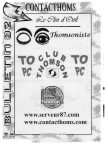
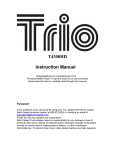

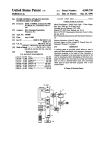
![BATTLEFIELD: BAD COMPANY [X360]](http://vs1.manualzilla.com/store/data/005724637_1-8a01f1e02d35e25dc4b532b2b3e1e619-150x150.png)


